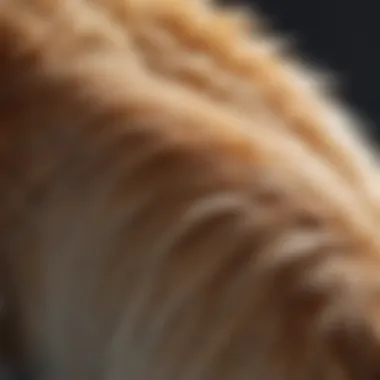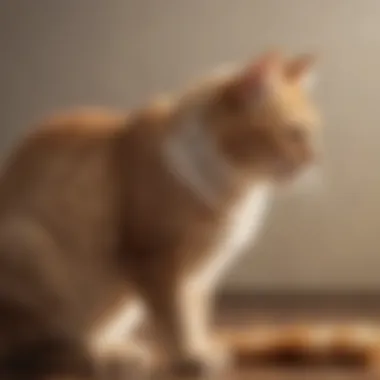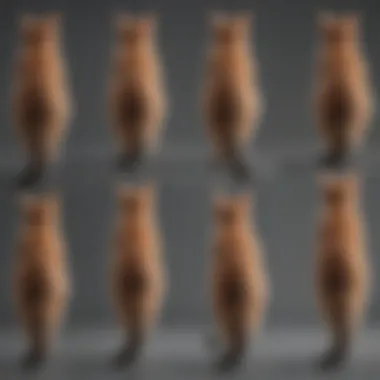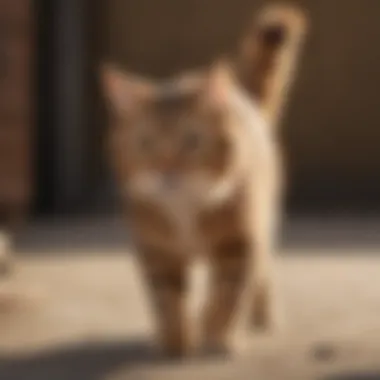Understanding Cat Tail Twitching: Behavior Insights


Intro
Understanding cat tail twitching is critical for cat owners, veterinarians, and wildlife biologists. Cat tail movements often characterize a cat's emotional state and intentions. This article examines the anatomy of the tail, its role in communication, and common contexts when this behavior occurs. By recognizing these aspects, owners can respond appropriately to their pets' needs and emotions.
Fascinating Facts About the Animal
Unique Characteristics
Cats have a diverse range of tail structures, varying greatly among breeds. Some, like the Manx, have very short tails, while others, such as the Maine Coon, have long and bushy tails. The tail is not just an extension of the body. It is also essential for balance. As cats are natural climbers, their tails help them maintain stability when navigating tricky terrain.
Extraordinary Abilities
Cats have an exceptional ability to express emotions through their tails. A cat can convey feelings such as excitement, aggression, or calmness simply by adjusting tail movements. According to recent studies, subtle movements can indicate changes in mood or focus. By paying attention to these signals, owners can gain insights into their cats' emotional wellbeing.
Behavior and Habitat
Natural Habitats
Domesticated cats share ancestral roots with wild feline species. They thrive in diverse habitats, including urban environments, forests, and grasslands. Their adaptability is astonishing, making them one of the most successful predators in various ecological niches. The tail plays a vital role in hunting and communicating within these settings.
Social Structures
Cats are often seen as solitary animals. However, they exhibit complex social structures when living in groups. Tail communication is key in social interactions, as cats will often use their tails to signal to others. This aspect emphasizes their ability to form bonds through non-verbal cues, where tail position can indicate submission or dominance.
Recent Scientific Discoveries
Latest Research Findings
Recent studies have revealed more about the connection between tail movement and emotional expression. Research indicates that different tail positions correspond to specific feelings. For instance, a high-held tail denotes confidence, while a low-hanging tail may indicate fear or submission. Understanding these behaviors can improve interactions between humans and their feline companions.
Breakthroughs in Animal Biology
Scientific advancements in animal behavior have shed light on the mechanisms behind physical signals like tail twitching. Researchers are investigating neural pathways that govern these movements. Such insights enhance our understanding of feline behavior and animal communication in general.
Cultural Significance
Animals in Folklore
Cats hold a significant place in folklore around the world. They are often seen as symbols of mystery, intuition, and independence. Their tail movements may play a role in these perceptions, as they often evoke curiosity about their inner lives. In some cultures, a cat's twitching tail was interpreted as an omen or a form of communication with the spiritual realm.
Influence on Art and Literature
The tail's expressive nature has also captured the attention of artists and writers. From classic paintings to modern literature, cats are frequently depicted with their tails in motion, signifying their complex emotional landscapes. This portrayal further reflects the intrigue surrounding feline behavior and their place in human culture.
Understanding a cat's tail movements can revolutionize the way we perceive feline communication and enrich our relationships with these enigmatic creatures.
Intro to Cat Tail Movement
In the realm of feline behavior, cat tail movement holds significant meaning. Understanding how and why cats move their tails can illuminate aspects of their emotional states and communication methods. This section serves as a primer, establishing the importance of tail movement as an indicator of feline moods and intentions. A nuanced grasp of this behavior enhances cat owners' ability to support their pets' well-being.
Importance of Tail Communication in Cats


Tail communication plays a critical role in how cats express themselves to their owners and other animals. Cats are not just vocal creatures; their non-verbal signals, especially tail movements, convey complex emotions. Different positions or twitches can indicate a variety of feelings, from contentment to agitation.
- Understanding intentions: Tail signals provide insights about a cat’s mood before any other behavior becomes apparent.
- Strengthening bonds: By interpreting these signals correctly, owners can respond more effectively to their cats, reducing misunderstandings and enhancing the human-feline bond.
- Assessing environments: Observing how a cat uses its tail can also indicate its comfort level in specific situations, helping owners tailor the cat’s environment appropriately.
Notably, the significance of tail communication lies in its subtlety. Owners who overlook these signals might miss out on cues that guide their interactions.
Overview of Cat Anatomy and Tail Functions
To fully appreciate cat tail movement, one must understand the anatomy of the tail and its various functions. The cat's tail is a complex structure composed of muscles, vertebrae, nerves, and skin, all contributing to its agility and communication. The tail consists of approximately 20 to 23 vertebrae, which provide the necessary flexibility for intricate movements.
- Balance and coordination: Cats rely on their tails for balance, especially when navigating narrow surfaces or executing sharp turns while running.
- Emotional expression: The tail serves as a visual indicator of a cat’s emotional state, helping convey feelings that might not be obvious through facial expressions or vocalizations.
- Social interactions: Through tail positioning and twitching, cats convey messages to other cats, and even to humans, signaling friendliness, dominance, or submission.
Recognizing these anatomical details equips owners to better interpret their cats' behavior, leading to improved interactions and a deeper understanding of feline needs.
Exploring the Mechanics of Tail Twitching
Understanding cat tail twitching requires a close look at the underlying mechanics that drive these movements. Tails are not just appendages; they play crucial roles in communication and emotional expression. By examining how neurological signals and muscle dynamics contribute to tail movement, we can better appreciate this subtle yet significant aspect of feline behavior.
Neurological Signals Driving Tail Movement
The first aspect to consider is the neurological signals involved in tail twitching. Cats have a complex nervous system that governs their physical movements. Specific brain regions send signals to the muscles in the tail, prompting it to twitch. This physiological interaction is essential for various tail movements. The spinal cord acts as a conduit for these signals, allowing rapid responses to stimuli.
Tail twitching can indicate a range of emotions, from excitement to irritation. Each twitch may be a response to environmental changes or internal states. In situations where a cat feels threatened or alert, the tail may twitch as a reflex to external stimuli. Understanding these signals can improve the way cat owners interact with their pets, allowing for more empathetic responses.
Understanding the neurological components of tail movement helps uncover what cats are trying to convey through their tails.
Muscle Control and Tail Dynamics
The second key element in the mechanics of tail twitching involves muscle control and dynamics. A cat's tail consists of a series of vertebrae, each connected by muscles and tendons that allow for flexibility and movement. The intrinsic muscles enable fine control for delicate movements, such as small twitches or broad swishes. When a cat is focused or intent, the muscles may contract in specific patterns, resulting in distinct types of twitches.
This intricate system of muscle control enables cats to express their emotional states effectively. Each twitch can signify different feelings, such as happiness, irritation, or playfulness. For example, a rapid twitch may indicate annoyance, while a slow, sweeping motion can express contentment. Recognizing these patterns is crucial for cat owners and animal professionals alike.
Tail Twitching as a Form of Communication
Cat tail twitching is a complex behavior that offers significant insight into feline emotions and communication. Understanding this form of communication is essential for both pet owners and animal professionals. Tail movements can reveal a lot about how a cat feels in different situations. This knowledge can enhance the relationship between cats and humans by allowing for better interaction and response to a cat's emotional state.
Interpreting Tail Position and Movement
The position of a cat's tail serves as a primary indicator of its emotional state. A raised tail often signifies confidence or happiness, while a lowered tail may suggest fear or submission. Observing the specific movements and posture of the tail can give clues about a cat's feelings. For example:
- Straight Up: A cat with its tail pointing straight up is likely feeling confident or content.
- Low or Tucked: This position generally indicates fear or a desire to hide.
- Twitching Tips: Quick, small twitches at the end of an upright tail can show excitement or curiosity.
- Rigid Base with Fast Twitches: This may indicate a cat is frustrated or highly focused, perhaps during play.
By clearly viewing the tail movements, one can begin to decode a cat's emotional language.
Different Types of Tail Twitches and Their Meanings
Tail twitches are not random actions but rather specific communications. Each twitch can denote different emotions or intents. Here are some common types of tail twitches and their meanings:
- Slow Twitch: This often signals a relaxed state. The cat may be in a calm environment.
- Rapid Twitch: Indicates heightened excitement or agitated behavior. This might happen during play or when startled.
- High and Steady Twitch: A sign of concentrated energy, indicating the cat is hunting or engaged.
- Lateral Twitches: When a cat moves its tail side to side while standing or sitting, it can mean annoyance or agitation.
Contexts for Tail Twitching in Cats


Understanding the contexts for tail twitching in cats provides valuable insights into their behavior. Each movement of a cat's tail communicates specific emotional states and intentions. Recognizing these cues enhances the relationship between pets and their owners, leading to a more harmonious living environment.
Tail Movement During Play
Tail twitching during play is often a sign of excitement and engagement. When a cat is in a playful mood, the tail may flick quickly from side to side. This motion indicates that the cat is actively involved in the play and may be preparing to pounce or interact with a toy. Observing this behavior can inform owners about their cat's energy levels and desire for interaction.
In play, cats may exhibit various tail movements, including:
- Swishing: A rapid back-and-forth motion that shows enthusiasm.
- Twitching tips: A slight twitch at the end of the tail may indicate focus, especially when stalking a toy.
- Puffed-up tail: This indicates excitement, but be cautious, as it can also signal overstimulation.
Understanding these movements enables owners to create enriching play sessions, tailored to their cat's preferences and energy.
Tail Twitches Indicating Stress or Anxiety
Tail twitches can also signify stress or anxiety. When a cat feels threatened or uneasy, its tail may twitch sharply or even thump against the ground. This behavior is often part of a broader array of warning signs, including flattened ears and dilated pupils. Recognizing these signals can help owners take appropriate action to alleviate their cat's discomfort.
Signs of stress or anxiety include the following:
- Twitching tail held low: A clear indicator of distress.
- Rapid tail movement: Can indicate agitation or frustration.
- Twitching with body tense: Suggests fear or aggression.
Owners should pay attention to these signs and consider the environment in which their cats are located. Reducing stress factors and creating a calm atmosphere can be beneficial.
Tail Signs of Contentment or Relaxation
A calm, relaxed tail can indicate a content cat. When a cat's tail is held high and slightly curved, it signifies a state of ease and confidence. The tail may sway gently when the cat is comfortable, showcasing satisfaction with its environment. This behavior is particularly seen when a cat is resting or interacting positively with its owner.
Some positive tail signals include:
- Upright position: Indicates confidence and comfort.
- Slow swaying: A sign of contentment, often seen when the cat is petted.
- Relaxed posture: A tail that rests loosely against the body signals relaxation.
These tail movements reassure owners that their cats are happy and stress-free. Fostering such an environment can strengthen the bond between the pet and its owner.
Understanding these different contexts for tail twitching aids in recognizing your cat's emotional state and can significantly enhance communication.
Common Misconceptions about Cat Tail Behavior
Understanding cat tail behavior requires separating fact from fiction. Misconceptions can lead to misunderstandings, influencing how owners perceive and respond to their cat's emotions. It's vital to communicate properly with our feline companions, as their tails serve as important indicators of feeling and intent.
Misunderstanding these signals can affect the bond between humans and cats. For example, assuming a twitching tail always indicates aggression might lead to unwarranted fear or caution. Clarity in interpreting tail movements helps in providing a safe and responsive environment for cats.
Myths Surrounding Feline Tail Movements
Several myths exist about cat tail behaviors. One common myth is that a high-held tail always means a happy cat. While it usually indicates confidence or contentment, this is not universally true. Depending on the context, a high tail can also signify alertness or territoriality.
Another myth is the idea that all tail twitching signals aggression. In reality, twitching can also indicate excitement, curiosity, or playfulness. It is crucial to observe the whole picture, including other body language cues and the environment.
Frequently held myths include:
- A tail position always represents a single emotion.
- All cats express the same tail signals uniformly.
- Only untrained or unsocialized cats display tail movements that are confused or erratic.
Understanding these myths can prevent misinterpretations that cause stress for both the cat and its owner.


Clarifying Misunderstandings in Cat Communication
Misinterpretation of cat tail movements can affect interactions. A cat may seem to be in a bad mood based on a drooping tail, but this could merely be a position of relaxation. Conversely, a vibrating tail may look threatening, when it could simply mean heightened excitement during play.
Recognizing the nuances of tail language is crucial in fostering a trusting environment. Knowing when a cat is signaling distress versus excitement extends beyond just tail position. Here are essential points to consider:
- Observe accompanying body language, such as ear position and vocalizations.
- Consider the context in which the tail movement occurs. A cat playing might express itself differently than when it's feeling threatened.
- Familiarize yourself with your cat's personal behavioral traits, as they may not conform strictly to generalized interpretations.
Integrating Tail Behavior into Feline Care
Integrating an understanding of tail behavior into feline care is crucial for both the welfare of the cat and the harmony of the human-animal relationship. The tail serves as an important tool for communication, reflecting a cat's emotional state and needs. By observing tail movements closely, pet owners can gain valuable insights into their feline companion's feelings.
Tail twitching can indicate various emotions, from excitement during play to stress in uncomfortable situations. Therefore, recognizing these signals allows owners to respond appropriately, whether that means engaging with the cat in play or providing comfort when it feels anxious. This understanding fosters a more responsive environment that can enhance the cat's overall well-being.
Incorporating tail behavior into daily interactions also aids in preventing misunderstandings. Cats might twitch their tails when excited or annoyed. If a cat's human misreads this as aggression, it could lead to unnecessary stress for both. Hence, educating oneself about these signals is beneficial, facilitating smoother communication and a stronger bond between the cat and its owner.
Key points to consider while integrating tail behavior into feline care include:
- Regularly observing tail movements during different activities.
- Understanding the context in which a cat twitches its tail.
- Learning to differentiate between various tail signals.
- Providing a safe space for the cat to express itself.
By focusing on these elements, pet owners can cultivate a more harmonious relationship with their cats, ensuring that both parties understand each other's communication effectively.
Observing Tail Movements for Behavior Assessment
To assess behavior through tail movements, it is important to be attentive to the positions and twitches. A raised tail often indicates confidence or happiness, while a lowered tail may suggest insecurity or submission. Regular observation can help establish baseline behaviors for individual cats.
Some behaviors to note include:
- Quick Twitches: Often signal excitement or anticipation, likely related to play or hunting instincts.
- Slow Swishes: Could indicate irritation or contemplation, a signal to proceed with caution.
- Fluffed Tail: This indicates fear or aggression, a definite red flag that requires careful attention.
By keeping a watchful eye on these movements, owners can readily identify shifts in their cat's mood, paving the way for appropriate responses.
Responding Appropriately to Tail Signals
Understanding how to respond to tail signals is just as critical as observing them. A positive reaction can reinforce good behavior and enhance trust. For example, if a cat shows excitement through a twitching tail during play, engaging with it in its playful activity is beneficial. On the other hand, if the tail is fluffed and quivering, it is wise to offer space and avoid unnecessary interaction until the cat calms down.
Some effective responses based on tail movement include:
- When the tail is high and twitching, initiate playful activities or show interest.
- If the tail is low and twitching, recognize the cat's discomfort and either give comfort or leave it alone.
- Observe for signs of stress, like rapid swishing or fluffed tails, and create a calmer environment by reducing noise and distractions.
The aim is to build a positive feedback loop where the cat feels understood and secure in its environment. Ultimately, recognizing and appropriately responding to tail signals is about fine-tuning the relationship between humans and their feline companions.
Epilogue: Building a Stronger Bond Through Understanding
Understanding cat tail twitching is not just an academic pursuit; it is essential for fostering a deeper connection with feline companions. Tail movements provide valuable insights into a cat’s emotional state and intentions, enabling owners to respond appropriately to their pets' needs. Recognizing these signals can improve not only mutual understanding but also the overall quality of the relationship between humans and cats.
The Role of Tail Communication in Cat-Human Relationships
Cats utilize their tails to express a wide range of emotions, from excitement to distress. Each twitch or flick conveys specific messages. For instance, a slow twitch may suggest contentment, while rapid movements could indicate agitation or excitement. By interpreting these signals correctly, owners can engage with their cats in a more meaningful way. This understanding enhances trust, as the cat feels that its feelings are acknowledged and responded to. Establishing this mutual recognition can lead to a more harmonious living environment.
Encouraging Communication Skills as a Pet Owner
Pet owners should strive to observe their cats regularly. Watching tail movements and recognizing patterns can greatly improve understanding. Consider documenting specific tail actions during various contexts, like playtime or naptime. Comparing observations can unveil new insights about individual cat behaviors. Additionally, responding to a cat’s tail signals with appropriate interactions can reinforce positive behavior. This practice encourages the cat to express itself more openly, further enhancing communication between pet and owner.
Key Takeaway: Building a bond through understanding necessitates attentive observation and responsive actions. Both the cat and the owner stand to benefit from a relationship founded on clear and mutual communication.
By recognizing the significance of tail communication, cat owners can become more attuned to their pets. This awareness leads to a stronger bond rooted in trust and communication, ultimately enriching the lives of both cat and owner.







